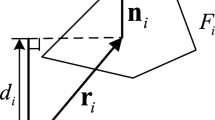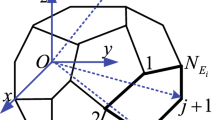Abstract
Two computational strategies for the evaluation of the spherical harmonic coefficients of the gravitational potential due to a generally shaped homogeneous polyhedral source are examined in detail. The techniques are implemented numerically for the known asteroid shape models of Eros and Didymos. The aim of the investigation is to quantify specific numerical aspects of the two algorithms, such as the accuracy of the techniques compared to a closed analytical solution for varying distance between source and computation point, the band-limited spectral analysis of the obtained spherical harmonic models and the convergence behavior of the corresponding series expansion in the vicinity of the characteristic Brillouin sphere. From a computational point of view, the line integral approach demands approximately three times the CPU time of Werner’s method. The two sets of spherical harmonic coefficients are 100% correlated up to degree 45 for Eros and up to degree 49 for Didymos. Approaching degree 100, the correlation by degree decreases by 0.0004% for Eros and by 0.004% for Didymos, the corresponding values for the correlation by order being 0.0002% and 0.304%. Inside the Brillouin sphere and approaching its boundary, the numerical agreement of the gravitational potential between the line integral method and the analytical solution is at the 1E-4 level, while with Werner’s approach at the 1E-7 level. At a distance of 33.5 km outside the Brillouin sphere for Eros and 2.2 km for Didymos, both methods are identical, reaching an agreement level with the analytical solution of 1E-11 level for Eros and 1E-14 for Didymos. In terms of spherical harmonic representation, the series defined by the line integral approach converges faster to the analytical value for the gravitational potential by 4 degrees.























Similar content being viewed by others
References
Balmino G (1994) Gravitational potential harmonics from the shape of an homogeneous body. Celest Mech Dyn Astron 60:331–364. https://doi.org/10.1007/BF00691901
Chao BF, Rubincam DP (1989) The gravitational field of Phobos. Geophys Res Lett 16:859–862. https://doi.org/10.1029/GL016i008p00859
Chen C, Chen Y, Bian S (2019) Evaluation of the spherical harmonic coefficients for the external potential of a polyhedral body with linearly varying density. Celest Mech Dyn Astron 131:8. https://doi.org/10.1007/s10569-019-9885-5
Colombo OL (1981) Numerical methods for harmonic analysis on the sphere
Cunningham LE (1970) On the computation of the spherical harmonic terms needed during the numerical integration of the orbital motion of an artificial satellite. Celest Mech 2:207–216. https://doi.org/10.1007/BF01229495
D’Urso MG (2014a) Analytical computation of gravity effects for polyhedral bodies. J Geodesy 88:13–29. https://doi.org/10.1007/s00190-013-0664-x
D’Urso MG (2014b) Gravity effects of polyhedral bodies with linearly varying density. Celest Mech Dyn Astron 120:349–372. https://doi.org/10.1007/s10569-014-9578-z
D’Urso MG (2015) A remark on the computation of the gravitational potential of masses with linearly varying density. Int Assoc Geodesy Symposia 142:205–212. https://doi.org/10.1007/1345_2015_138
Gottlieb RG (1993) Fast gravity, gravity partials, normalized gravity, gravity gradient torque and magnetic field: derivation, code and data. In: NASA contractor report 188243, National aeronautics and space administration lyndon B. Johnson Space Center Houston, TX, United States
Heiskanen WA, Moritz H (1967) Physical geodesy. W. H. Freeman and Company, San Francisco
Hu X, Jekeli C (2015) A numerical comparison of spherical, spheroidal and ellipsoidal harmonic gravitational field models for small non-spherical bodies: examples for the martian moons. J Geodesy 89:159–177. https://doi.org/10.1007/s00190-014-0769-x
Jamet O, Tsoulis D (2020) A line integral approach for the computation of the potential harmonic coefficients of a constant density polyhedron. J Geodesy 94:30. https://doi.org/10.1007/s00190-020-01358-8
Jamet O, Thomas E (2004) A linear algorithm for computing the spherical harmonic coefficients of the gravitational potential from a constant density polyhedron. In: Proceedings of the 2nd international GOCE user workshop “GOCE, the geoid and oceanography”, ESA-ESRIN, Frascati, Italy, 8–10 March 2004, ESA SP-569, June 2004
Lien SL, Kajiya JT (1984) A symbolic method for calculating the integral properties of arbitrary nonconvex polyhedra. IEEE Comput Graph Appl 4:35–42. https://doi.org/10.1109/MCG.1984.6429334
Miller JK, Konopliv AS, Antreasian PG, Bordi JJ, Chesley S, Helfrich CE, Owen WM, Wang TC, Williams BG, Yeomans DK, Scheeres DJ (2002) Determination of shape, gravity, and Rotational State of Asteroid 433 Eros. Icarus 155:3–17. https://doi.org/10.1006/icar.2001.6753
Nagy D, Papp G, Benedek J (2000) The gravitational potential and its derivatives for the prism. J Geodesy 74:552–560. https://doi.org/10.1007/s001900000116
Naidu SP, Benner LAM, Brozovic M, Nolan MC, Ostro SJ, Margot JL, Giorgini JD, Hirabayashi T, Scheeres DJ, Pravec P, Scheirich P, Magri C, Jao JS (2020) Radar observations and a physical model of binary near-Earth asteroid 65803 Didymos, target of the DART mission. Icarus 348:113777. https://doi.org/10.1016/j.icarus.2020.113777
Petrović S (1996) Determination of the potential of homogeneous polyhedral bodies using line integrals. J Geodesy 71:44–52. https://doi.org/10.1007/s001900050074
Rummel R, Rapp RH, Suenkel H, Tscherning CC (1988) Comparisons of global topographic/isostatic models to the Earth’s observed gravity field
Saraswati AT, Cattin R, Mazzotti S, Cadio C (2019) New analytical solution and associated software for computing full-tensor gravitational field due to irregularly shaped bodies. J Geodesy 93:2481–2497. https://doi.org/10.1007/s00190-019-01309-y
Singh B, Guptasarma D (2001) New method for fast computation of gravity and magnetic anomalies from arbitrary polyhedra. Geophysics 66:521–526. https://doi.org/10.1190/1.1444942
Takahashi Y, Scheeres DJ (2014) Morphology driven density distribution estimation for small bodies. Icarus 233:179–193. https://doi.org/10.1016/j.icarus.2014.02.004
Tsoulis D (2000) A note on the gravitational field of the right rectangular prism. Bollettino di Geodesia e Scienze Affini 59:21–35
Tsoulis D (2012) Analytical computation of the full gravity tensor of a homogeneous arbitrarily shaped polyhedral source using line integrals. Geophysics 77:F1–F11. https://doi.org/10.1190/geo2010-0334.1
Tsoulis D, Gavriilidou G (2021) A computational review of the line integral analytical formulation of the polyhedral gravity signal. Geophys Prospect 69:1745–1760. https://doi.org/10.1111/1365-2478.13134
Tsoulis D, Jamet O, Verdun J, Gonindard N (2009) Recursive algorithms for the computation of the potential harmonic coefficients of a constant density polyhedron. J Geodesy 83:925–942. https://doi.org/10.1007/s00190-009-0310-9
Tsoulis D, Patlakis K (2013) A spectral assessment review of current satellite-only and combined Earth gravity models. Rev Geophys 51:186–243. https://doi.org/10.1002/rog.20012
Tsoulis D, Petrović S (2001) On the singularities of the gravity field of a homogeneous polyhedral body. Geophysics 66:535–539. https://doi.org/10.1190/1.1444944
Werner RA (1994) The gravitational potential of a homogeneous polyhedron or don’t cut corners. Celest Mech Dyn Astron 59:253–278. https://doi.org/10.1007/BF00692875
Werner RA (1997) Spherical harmonic coefficients for the potential of a constant-density polyhedron. Comput Geosci 23:1071–1077. https://doi.org/10.1016/S0098-3004(97)00110-6
Werner RA, Scheeres DJ (1997) Exterior gravitation of a polyhedron derived and compared with harmonic and mascon gravitation representations of asteroid 4769 Castalia. Celest Mech Dyn Astron 65:313–344. https://doi.org/10.1007/BF00053511
Acknowledgements
The first author (GG) was supported by the Hellenic Foundation for Research and Innovation (HFRI) under the 4th Call for HFRI PhD Fellowships (Fellowship Number: 10834). Special thanks to Robert Werner and Olivier Jamet for providing relevant source code. Finally, we would like to acknowledge the detailed comments of two anonymous reviewers, that helped us improve the clarity of the presentation.
Author information
Authors and Affiliations
Corresponding author
Ethics declarations
Conflict of Interest
The authors declare no conflict of interest for the present contribution.
Additional information
Publisher’s Note
Springer Nature remains neutral with regard to jurisdictional claims in published maps and institutional affiliations.
Rights and permissions
Springer Nature or its licensor (e.g. a society or other partner) holds exclusive rights to this article under a publishing agreement with the author(s) or other rightsholder(s); author self-archiving of the accepted manuscript version of this article is solely governed by the terms of such publishing agreement and applicable law.
About this article
Cite this article
Gavriilidou, G., Tsoulis, D. Evaluation Procedures for the Potential Harmonic Coefficients of a Generally Shaped Polyhedron. Surv Geophys 45, 315–348 (2024). https://doi.org/10.1007/s10712-023-09802-y
Received:
Accepted:
Published:
Issue Date:
DOI: https://doi.org/10.1007/s10712-023-09802-y




